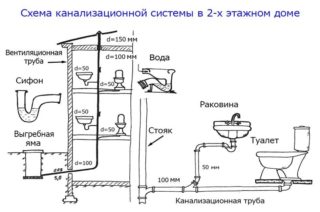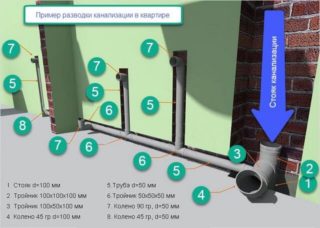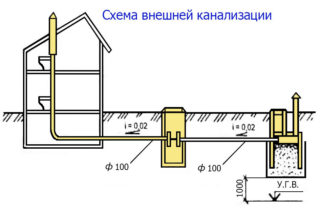Sewerage design is the main stage in the creation of networks for wastewater disposal. Drawing up a scheme and a plan of the system allows you to avoid installation errors, prevent contamination of drinking water sources.
Actual requirements for the installation of sewerage systems
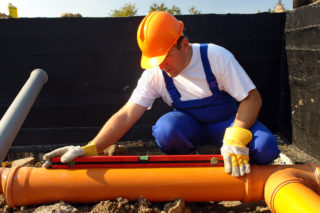
The main difficulties of the sewerage device lie not so much in the specificity of the work, but in compliance with the requirements and norms:
- The slope of the pipeline should be 2-15% to the internal networks, external sewerage and septic tank. The exact angle is determined depending on the size of the pipes and the type of plumbing fixtures.
- Pipe diameter. For a bidet and washbasin, the optimal diameter of the sewer outlet is 32-40 mm, for the sink - 50 mm, for the toilet - 110 mm. The uprights are made of products with a size of 70-110 mm.
- Warming. The sewer pipeline must be covered with fiberglass or polyethylene.
- Ventilation. Thanks to this system, the pressure of the gases released during the flow of waste water is regulated. For this purpose, sewer wells are installed. If there are several collectors in the house, each of them must have ventilation.
When equipping a system with wastewater discharge into a storage tank, it is necessary to provide the possibility of a sewer truck access.
Choice of materials
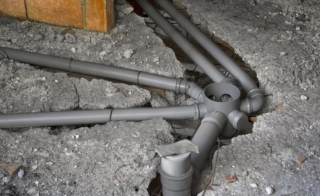
For the installation of sewage systems, polymer and metal elements are usually used. A variety of materials allows you to choose products with an optimal price-quality ratio.
Cast iron pipes have several advantages:
- high strength;
- reliability;
- resistance to temperature extremes;
- long service life;
- the ability to withstand severe mechanical stress.
The demand for cast iron pipes began to fall rapidly with the advent of plastic products. This is due to the high cost of metal elements, their heavy weight and the complexity of transportation.
When installing sewerage systems from plastic pipes, choose products made of PVC, polypropylene and polyethylene elements. Subject to the general rules and regulations of operation, such sewerage sections serve for more than 50 years. It is easy to install polymer products with your own hands without special equipment.
In addition to the pipes themselves, for laying the sewage system you will need fittings, sealing compounds, and a set of tools. Support structures should be used to properly anchor network sections to the basement floor (if necessary).
Design and preparatory stage
- is it possible to connect the building to centralized networks;
- how the waste will be disposed of in an autonomous system;
- how much wastewater will be produced daily;
- whether the private house will be constantly operated;
- to what depth the soil freezes, and what is the level of groundwater at the site.
Sewerage and water supply projects are drawn up jointly. An integrated approach allows you to avoid mistakes and make the sewage system as efficient as possible. The document indicates:
- General data containing the title of regulations and the composition of the project.An explanatory note for the installation of water supply and sewerage systems is placed in this section.
- Legend of premises - contains a plan of all floors with an indication of the wet areas and instructions for their waterproofing.
- Calculation of water consumption and water disposal. The section contains the relevant standards and calculations are made taking into account a specific house - multi-apartment or suburban.
- Plumbing plan - contains the exact location of plumbing fixtures.
- Sewerage scheme - it shows the routes of laying pipes with an indication of their dimensions and the location of risers.
- A specification that lists the required hardware, fasteners, pipes and fittings.
The preparatory stage before carrying out the sewerage consists in the following actions:
- Decide on the number of plumbing fixtures and their location.
- Provide the possibility of installing additional equipment for which you will need to install a sewer drain. To do this, it is necessary to install a closable type lead with a plug.
- After calculating all the parameters, cut the pipes, taking into account the parameters of the fittings. For plastic items, you can use a metal hacksaw. It is necessary to cut at right angles. After the procedure, the edges should be cleaned with a knife or sandpaper.
- It is necessary to install the sewer pipeline at a slope, for which special brackets are used.
Before laying the sewer, prepare a grinder, a drill or perforator, an assembly gun, a chisel, a hammer, a screwdriver and an adjustable wrench.
Installation steps
Internal sewerage device
Before installing the internal sewerage and water supply systems, old pipes are removed. Stages of technical work:
- The hot and cold water supply is cut off.
- With an adjustable wrench, remove the hose used to conduct water to the toilet cistern.
- Remove the toilet.
- Completely clean the bathroom.
- Disassemble the old sewage system.
- Remove the pipes located next to the riser. Eliminate elements extending from the tee mounted in the riser.
Before bringing new pipes to the riser, it is necessary to clean up the remnants of the old sealant and install a new collar.
Recommendations for the installation of internal sewerage:
- The toilet is connected to the network with a plastic pipe with a diameter of 110 mm. Next, a smooth transition is made to a section of 50 mm in size. A suitable option is to create a bridge with a 100 mm product.
- The drain and the slope are set at the same level, and the joints are sealed.
- It is undesirable to use adapters with right angles. It is better to use 2 elements with a 45 degree rotation. Wiring in bathrooms does not require socket welding of pipes.
- Complete sewerage assembly is carried out. The pipes are inserted into each other, sealing the joints.
- For reliable fastening of hot cold and hot water supply networks, it is worth using silicone sealant.
- At the final stage of work, the internal network is connected to the external sewage system.
Sections of the network must be fastened to the walls with clamps. Thanks to these elements, a reliable fixation of the pipeline is ensured.
External sewerage
Features of outdoor sewerage device technology:
- The size of the pit for the septic tank is chosen depending on the intensity of the use of plumbing fixtures and the number of people living in the house. For 4 people, it is necessary to build a cesspool with 3 rings 1 m high and 1.5 m in diameter.At the summer cottage, you can install a simple septic tank of minimum volume.
- Before the installation of concrete rings, a sand cushion 15-20 cm thick is made. Subsequently, it is poured with concrete, and after a day the rings are installed. The joints between concrete elements are sealed with resin or bitumen.
- To lay an external sewer pipe (minimum diameter 11 cm), dig a trench from the septic tank to the foundation of the house. It is important to take into account the depth of soil freezing in the region. If it is 1 m, the trench should be so deep that the top edge of the pipe is below this level. If the depth of soil freezing is too deep, it is necessary to continue the sewage system at a meter depth, and insulate it. The slope of the outdoor system piping should be 2-3 cm per meter.
- To connect the pipe to the septic tank, it is necessary to drill a hole in it with a grinder. To preserve the pipeline, the walls of the septic tank should be wrapped with insulation.
When connecting pipes to the external sewage main, it is necessary to lubricate the joints with special glue. If it is necessary to arrange bends, use knees with the most smooth angle of rotation.
The pipe enters the house through the basement or foundation. It is better if it is carried out before pouring the base. To do this, use a sleeve - a wider pipe that protects the sewer from mechanical pressure.
The filtration well should be located 30 cm below the septic tank. The volume of the well may be less than the accumulator. Such a structure should not have a concrete bottom. Gravel or crushed stone is poured into it with a layer of 30 cm.
Storm sewer
- Installation of storm water inlets fixed with bitumen mastic.
- Placement of pipes or trays, depending on the selected precipitation collection system (linear or point).
- Placement of risers.
- The organization of the spillway - into a tray or collector.
Storm sewers are arranged in the following order:
- The territory is marked out using a tracing cable.
- Excavation work is carried out, during which wells and trenches are laid, ditches are made for the installation of ground trays.
- Install ground-based storm water inlets.
- Trays and pipes are placed in the designated places.
- They combine disparate elements into a single storm sewer system.
Before starting operation, it is necessary to carry out a test pouring. During operation, the network is regularly cleaned.
The cost of laying sewage systems
The approximate cost of creating a sewage disposal system, including the cost of laying one running meter of sewage in the ground:
| Name of works | Prices, rub. |
| Sewerage wiring - installation of a point, which includes revisions, risers, plugs and odorants | 2200 |
| Thermal insulation of pipes - broaching pipes in a heater | 80 |
| Works on laying the yard sewage network | 220 |
| Excavation | 1500 |
| Slitting a concrete wall for a pipe | 1000 |
| Shtroblenie masonry under the pipe | 700 |
| To Create a Hole in the Foundation for a Pipe Outlet | 3500 |
The price for work on the installation of sewerage varies depending on the region.
Collect the internal and external sewerage system should take into account the documentation, which indicates the parameters of the house and land. If the basic requirements are met, the system will drain wastewater as efficiently as possible, and there will be no difficulties with its repair.

